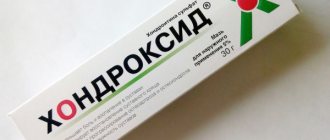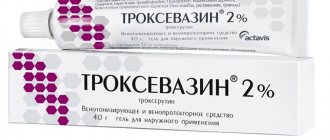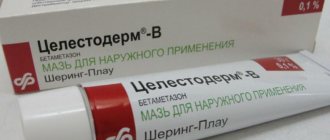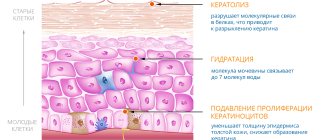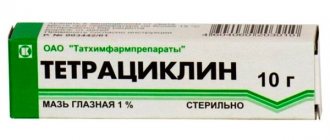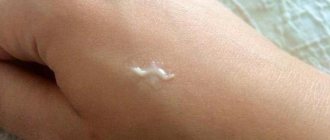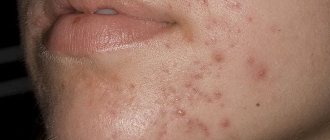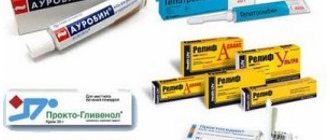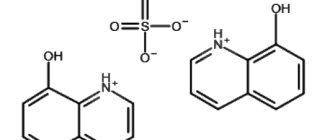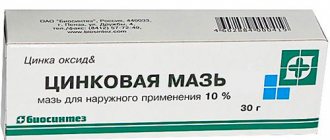Deep damage to the skin may leave an unsightly scar that is difficult to treat. Therefore, it is best to play it safe and use ointment to heal wounds. Such products accelerate tissue regeneration and prevent infection. The texture of the ointments is convenient for the treatment of small cracks and large lesions.
What to use in the first stage
Regenerating agents are selected taking into account the degree of tissue damage and the type of wound. There are wound-healing ointments for treating superficial wounds - shallow cuts, abrasions and scratches. And means for solving more dangerous problems - burns, trophic wounds, festering abscesses. Any wound, regardless of origin, has two stages of development and healing: inflammatory and restorative.
At the first stage, the wound bleeds and becomes inflamed, the damaged tissues die, and during this process ichor and pus can be released. At the first stage, an antiseptic healing ointment should be used.
pros
- Relieves inflammation.
- Disinfect.
- Easy to apply.
- Can be used without consulting a doctor.
- Sold in pharmacies without a prescription.
Minuses
- They have contraindications and side effects.
- There is a risk of allergic reactions.
- These remedies are not equally suitable for everyone.
- Some people may be intolerant to the components included in the ointments.
Healing wounds of any origin begins with their disinfection. For this purpose, antiseptic and antibacterial agents are used. First, the wound must be treated with a solution of iodine, green diamond or hydrogen peroxide. Then one of the following products is applied to the weeping abrasion.
Ointment for skin irritation after shaving
Shaving is a stressful procedure for the skin. Irritation can occur in both men and women. As a rule, it goes away within a few minutes. However, when the irritation is severe and bothersome, you can apply Baziron ointment to the skin.
The drug acts as an antibacterial agent, quickly eliminates itching, redness, and fights rashes. Most often, Baziron is prescribed for the treatment of acne, to reduce the severity of allergic reactions, and to moisturize the skin. It is possible to use the ointment prophylactically to prevent skin irritation after shaving. To do this, it must be applied after each procedure.
Side effects include burning, itching and redness of the skin. The ointment should not be used to treat children under 12 years of age.
Rating of the best ointments for wound healing, applicable in the first stage of treatment
| Rating | #1 | #2 | #3 |
| Name | Levomekol | Streptoplaven | Nitacid |
Rescuer
An effective drug with analgesic, antiseptic, anti-inflammatory and healing effects. Effective for scratches, abrasions, cuts and bruises.
pros
- Made from plant ingredients.
- It has virtually no contraindications or side effects.
- The effect is noticeable immediately after application.
- Treats diaper rash, dermatitis, acne, burns, frostbite, cracked nipples during breastfeeding.
- Suitable for children's first aid kit.
- Affordable price.
Minuses
- Not the best remedy for healing complex, festering wounds.
- Sometimes plant components provoke allergic reactions.
Streptoplaven
Wound healing occurs through the melting of dead cells and their rejection. Primarily used in the treatment of trophic ulcers and deep burns.
pros
- Contains miromistin, which additionally disinfects wounds.
- The drug is made on a water basis, thanks to which the active components easily penetrate into the deep layers.
- Helps fight gangrene, which is a consequence of diabetes or atherosclerosis.
Minuses
- To achieve a good effect, you need to use a large amount of ointment.
- Active components may cause allergic reactions.
Nitacid
An effective remedy for treating suppurating wounds. Contains streptocide and netazol, the combination of these two substances provides an effective effect on almost all types of bacteria.
pros
- Widely used for disinfection of postoperative sutures, treatment of abscesses and purulent wounds.
- Effective for wounds of thermal origin of varying degrees of severity.
- For purulent injuries, it is enough to place a tampon soaked in this product on the wound once a day.
- For burns, the damage is treated with the product at least twice a week.
Minuses
- As a powerful antibacterial agent, it has a number of contraindications.
- Not tolerated equally well by all patients.
Eplan
A powerful anti-infective agent with universal action. Immediately after injury, it quickly relieves swelling, helps stop bleeding, and reduces pain.
Subsequently, it disinfects the surface of the wound, destroys pathogenic microflora and effectively cleans the wound before applying other drugs.
pros
- It treats not only abrasions, cuts, burns and frostbite, but also bedsores, weeping eczema, ulcers, and herpes.
- Effective against fungal infections.
- Allowed for pregnant and lactating women.
- Available in the form of a solution, ointment and napkins soaked in a solution of the drug.
Minuses
- Do not apply to open bleeding wounds, as Eplan affects blood clotting.
Levomekol
The active component of this drug is chloramphenicol; most microbes are sensitive to this substance. It also contains methyluracil, which has the unique property of increasing the natural immunity of cells.
The ointment is spread in a thin layer on the cleaned surface of the wound, and a sterile bandage is applied on top. The procedure is performed up to four times a day until the wound begins to heal.
pros
- The drug has a wide spectrum of action - the ointment can be used to disinfect both small cuts and abrasions, as well as poorly healing purulent wounds, weeping ulcers, and thermal injuries.
- Used for rapid fusion of postoperative sutures.
- Available without a prescription and inexpensive.
Minuses
- Contains antibiotics, therefore it has a number of contraindications.
- Not the most convenient method of application - the wound must be constantly cleaned and disinfected, and only after that apply the product, and then apply a bandage
- Some patients have individual intolerance to the active components of this ointment.
Folk remedies
Wound healing ointments can be made according to folk recipes at home. If desired, you can make a product with an antibiotic by adding the desired drug to the finished mixture. Homemade ointments are suitable for treating minor injuries. For the treatment of weeping wounds, it is better to use pharmaceutical medications.
Egg mixture
Egg mixture helps heal shallow scratches and burns
Recommended for use on burns and minor scratches. The remedy has a calming and analgesic effect. For cooking you will need 7 large eggs. You can take mint essential oil (as an additional ingredient).
Recipe:
- First you need to boil all the eggs and peel them.
- Next step: separating the whites from the yolks. To implement this recipe you will need the yolks. They need to be ground to a homogeneous paste.
- Then the yolk mixture should be placed in a frying pan and fried over low heat. Fry for 30-40 minutes in olive oil.
- The final step will be making egg butter. To do this, you will need to carefully strain the fried pulp from the yolks.
The oil must be applied to skin lesions 2-3 times a day. The product helps to quickly get rid of burns and blisters.
Beeswax and lard
Beeswax and pork fat
This recipe will make a good ointment that will promote rapid healing of cracks, wounds, burns and cuts. To prepare the product, you will need to take 1 tablespoon each of beeswax and fat. By the way, you can use not only pork fat, but also lamb fat. Ideally, you will need another 1 tablespoon of colophon resin (rosin).
All ingredients must be melted in a water bath, then strained several times using gauze. The product is applied in a thin layer 1-2 times a day.
What to use in the second stage
Each stage has its own optimal means. You should not prematurely use a healing cream that promotes the formation of new tissues - pus may remain under the young thin skin, it will accumulate and ultimately lead to serious complications, including opening the abscess and cleaning the wound surgically. And only when all the pus is completely drained can you begin to use a regenerating agent for wounds and cracks. At the second stage, wound healing begins , the release of purulent exudate decreases, the wound dries out, and the tissue around it gradually begins to scar and recover.
pros
- Effectively dry and restore damaged tissues.
- Can be used to heal various wounds, including burns and frostbite.
- Penetrate deep into the layers of the skin and restore cells.
- Prevents the inflammatory process.
Minuses
- The need to pre-treat the wound with antiseptic and disinfectants.
- Some ointments have side effects.
- People with individual intolerance to the components of the drug may experience allergic reactions.
When dead tissue has already been removed, purulent discharge is insignificant, wound healing moves to the next stage. New, healthy tissue begins to form, and the wound becomes scarred. To speed up this process and prevent scars, various regenerating agents are used.
Causes of joint pain
Joints are the movable part of the skeleton that connects all the bones into a single system. They are responsible for bending, straightening, rotation, twisting and, in principle, for the movement of the body as a whole. And, naturally, pain in the “hinges” is the first sign that the functions of the musculoskeletal system are impaired. Therefore, it is worth taking the problem as seriously as possible and addressing it as early as possible.
In fact, the joint cannot hurt because it is devoid of nerve endings. But they are adjacent to the surface of the synovial bursa. It is a flattened cavity, inside of which there is a thick jelly-like liquid that acts as an intra-articular lubricant.
If the integrity of the joint is threatened (virus, toxins, salts and other foreign agents), then the signal is transmitted to the brain, and the body responds with pain.
It can be so unbearable that a person tries to completely limit movements so as not to disturb the diseased joint. However, even at rest, aching and disturbing pain may continue, which can only be pacified with painkillers.
Provoking factors
Why may joint pain occur? Let's look at the main reasons.
- Sedentary lifestyle. The average office worker sits at the computer for hours, gets to work and home by car or public transport, and at home as quickly as possible lies down on his or her sofa watching the TV. Muscles are sorely lacking in physical activity, they atrophy and no longer support bones and joints. As a result, various types of arthralgia develop.
- Sports and increased physical activity. The other side of the coin is that excessive movement and heavy loads lead to pain in the spine and limbs. Not only athletes are at risk, but also people in working professions - builders, loaders, sellers, hairdressers. All of them develop occupational diseases with age, including joint ones.
- Obesity. Increased body weight “flattens” cartilage tissue, which serves as a kind of shock absorber and protects bones from abrasion. If the weight is increased due to muscle tissue, then this is not a problem - the muscle corset, on the contrary, maintains the entire musculoskeletal system in good health. Another thing is fat, which acts on the joints like a hydraulic press. If you don’t start losing weight on time, you will be guaranteed arthrosis.
- Ecology. People living in industrial areas do not know what clean air is. They are accustomed to breathing exhaust gases and various harmful emissions. All this weakens the immune system and creates fertile ground for the penetration of viruses and other pathogenic organisms.
- Nutrition. A lack of nutrients and elements will undoubtedly lead to health problems, which will certainly affect the connective tissue. High-calorie and refined foods have a detrimental effect on joint tissue, since they are deprived of essential vitamins, fatty acids, micro- and macroelements. An unbalanced diet leads to a loss of tissue elasticity; as a result, not only older people, but also children can suffer from joint diseases.
- Age. Here we are talking about banal wear and tear on the body. The older a person is, the more often he begins to complain of joint pain.
- Disruption of endocrine processes. This is one of the key reasons for the occurrence of osteoarticular pathologies. Since the body experiences a deficiency of certain hormones, the redistribution of substances is disrupted and bone and cartilage tissue is destroyed.
- Heredity. There are diseases of the musculoskeletal system that are transmitted genetically, there is nothing you can do about it.
Possible diseases
The most common joint diseases are the following pathologies.
- Arthritis is the stagnation of lymph and blood in the tissues, as a result of which the destruction of bone and cartilage tissue begins.
- Bursitis is the accumulation of excess fluid in the synovial bursa, which contributes to the occurrence of an inflammatory process.
- Gout is a type of arthritis characterized by increased uric acid production combined with impaired kidney function. It is a disease of dancers, older people and high heel wearers.
- Arthrosis is deformation of bone tissue due to thinning of cartilage.
- Joint necrosis - appears due to impaired blood flow in the bone tissue, which leads to death.
- Injuries and dislocations. Failure to seek medical help in a timely manner can lead to necrosis, the development of serious diseases and disability.
Rating of the best ointments for wound healing, applicable in the second stage of treatment
| Rating | #1 | #2 | #3 |
| Name | Actovegin | D-panthenol | Bepanten |
Baneocin
Another universal antiseptic and wound healing agent. In powder form it can be used immediately after injury.
For tissue regeneration and rapid scarring, it is preferable to use a cream.
pros
- Contains lanolin, which prevents drying out and cracking of the drying wound.
- Forms a protective film, preventing infection from re-entering the wound.
- It is used in pediatrics to treat the umbilical wound in newborns.
Minuses
- Not the most affordable remedy; you can’t find it in every pharmacy.
- It is quite expensive compared to other drugs.
Solcoseryl
This product is made from an extract of calf blood serum, deprived of natural protein through special processing. Active components quickly penetrate deep into tissues, accelerate metabolic processes at the cellular level and thereby help to quickly restore damaged skin.
pros
- Effectively saturates cells with oxygen and nutrients.
- Accelerates metabolic processes.
- Forms a protective fatty film on the surface of the wound, which prevents re-infection.
- Relatively low price.
Minuses
- The effect of the drug has been little studied.
- Despite the fact that the drug is based on natural raw materials, intolerance to this drug is often noted.
- The ointment can be applied only after the surface of the wound has been disinfected. Otherwise, tissue suppuration may occur.
Actovegin
A broad-spectrum drug available in various pharmaceutical forms - as tablets, injection solution, ointment for external use. Wound healing ointment acts in two directions at once: it destroys bacteria and improves tissue regeneration.
pros
- Can be used at any stage of healing of scratches, abrasions, cuts and burns.
- Helps even with severe, long-term non-healing skin lesions, bedsores, and trophic ulcers.
- Economical to use.
Minuses
- The effect of the drug has not been fully studied; it is banned in some European countries.
- Has side effects.
Bepanten
This product also affects metabolic processes in skin cells and stimulates its regeneration. The active component is dexpanthenol.
pros
- It quickly penetrates deep into tissues, is converted into pantothenic acid and interacts with epithelial cells.
- Prevents the development of the inflammatory process.
- Effective in the treatment of burns of various origins.
- Can be used for preventive purposes as a diaper cream in the care of newborns.
- Strengthens local immunity.
Minuses
- In case of individual intolerance to the components of the drug, it causes allergic reactions.
D-panthenol
The active ingredients of this ointment activate collagen production and regulate metabolic processes at the cellular level. Dexpanthenol, the main active component of the product, contains pantothenic acid, without which the formation of epithelial cells is impossible.
pros
- Indicated for the treatment and prevention of diaper rash in infants.
- Helps with burns and frostbite.
- Heals cracked nipples in women.
Minuses
- It has only a slight antiseptic and anti-inflammatory effect, so the wound must be disinfected before distributing the ointment.
- To obtain a good effect, the ointment should be applied many times, after first cleaning and disinfecting the damaged areas of the skin.
Indications for the use of wound healing ointments
Pharmacies have a large selection of ointments that promote rapid healing of skin injuries.
Depending on the main action and indications, they are divided into groups:
- Anti-inflammatory. Used for closed bruises (without rupture of soft tissue), muscle sprains, and joint diseases.
- Disinfecting ointments. Helps with abrasions, cracks, scratches, and is effective for cuts. They disinfect injured areas and create a barrier for infection to enter the body.
- Antibiotic ointments. Prescribed for purulent wounds, postoperative sutures, cracks that bleed heavily. Such remedies heal ulcers, burns and erosive lesions on the skin.
- Regenerating ointments. Used to treat open wounds, abrasions, trophic ulcers, frostbite of varying severity.
- Drying. Used for weeping wounds, purulent cracks on the arms or legs.
conclusions
These were the most effective, reliable and most frequently sold medications for disinfecting any skin damage and quickly restoring damaged tissue (according to reviews and surveys of doctors). Returning to the original question - which ointment is the best for wound healing, taking into account the above review of various products, we can conclude: the best universal ointment does not exist. Your home medicine cabinet should have at least two of the products listed above to treat skin lesions at different stages of healing.
Antipruritic medications
The use of antipruritics is important in the presence of allergic rashes. For this purpose, hormonal ointment is often used, which includes Sinaflan.
Many people mistakenly believe that it can be used for ordinary acne, not suspecting that the drug in some cases can only worsen the condition of the skin. Treatment with Sinaflan is only relevant in the presence of an allergic rash and inflamed elements that have arisen against the background of seborrhea. For other acne, hormone-containing medicine is contraindicated.
Cost: 70-90 rubles per 10 g.

